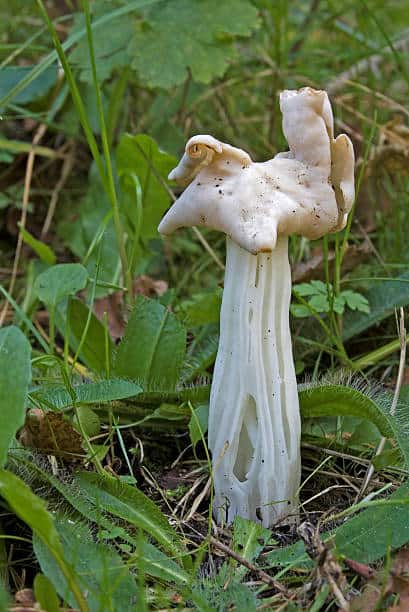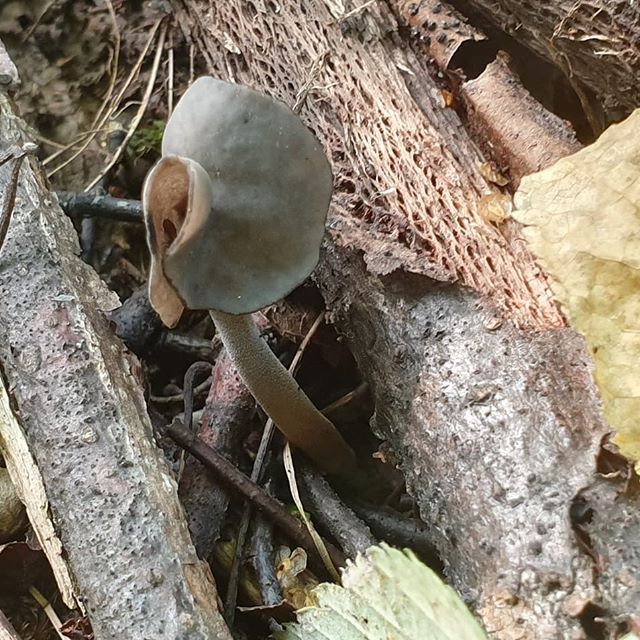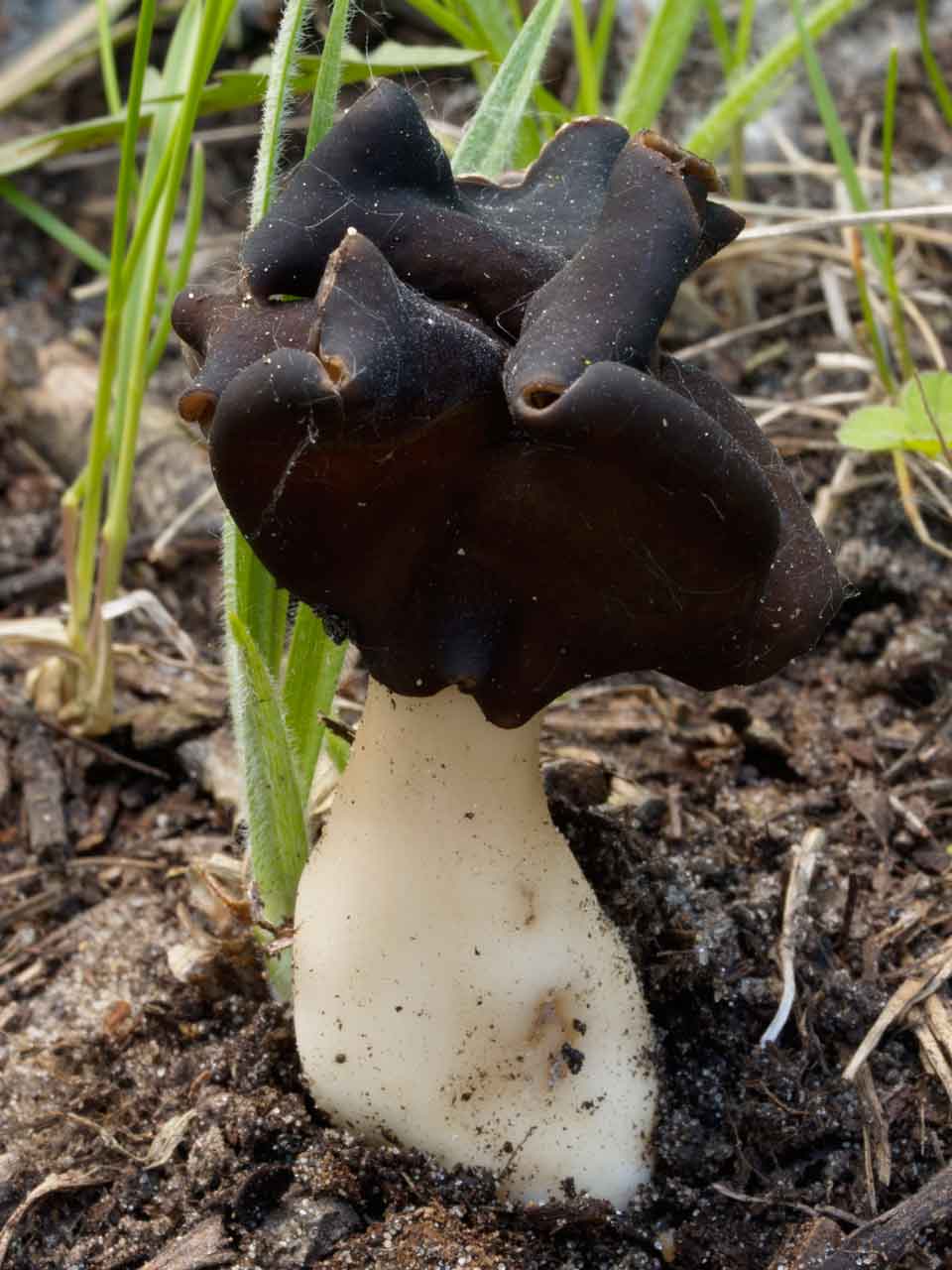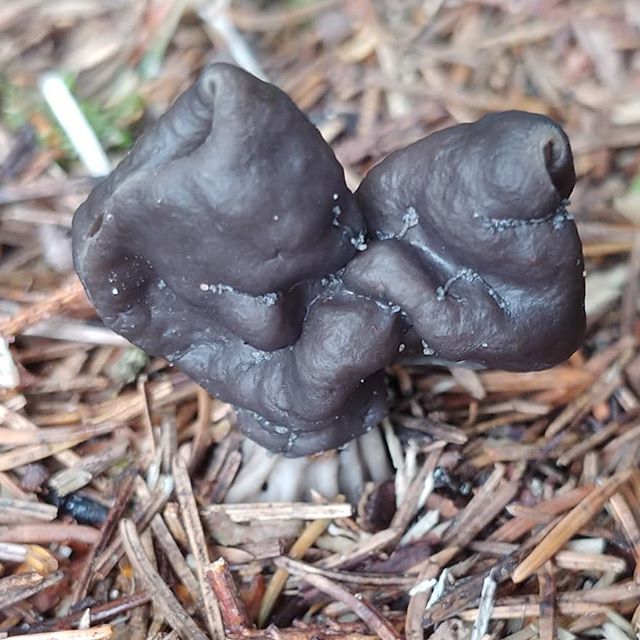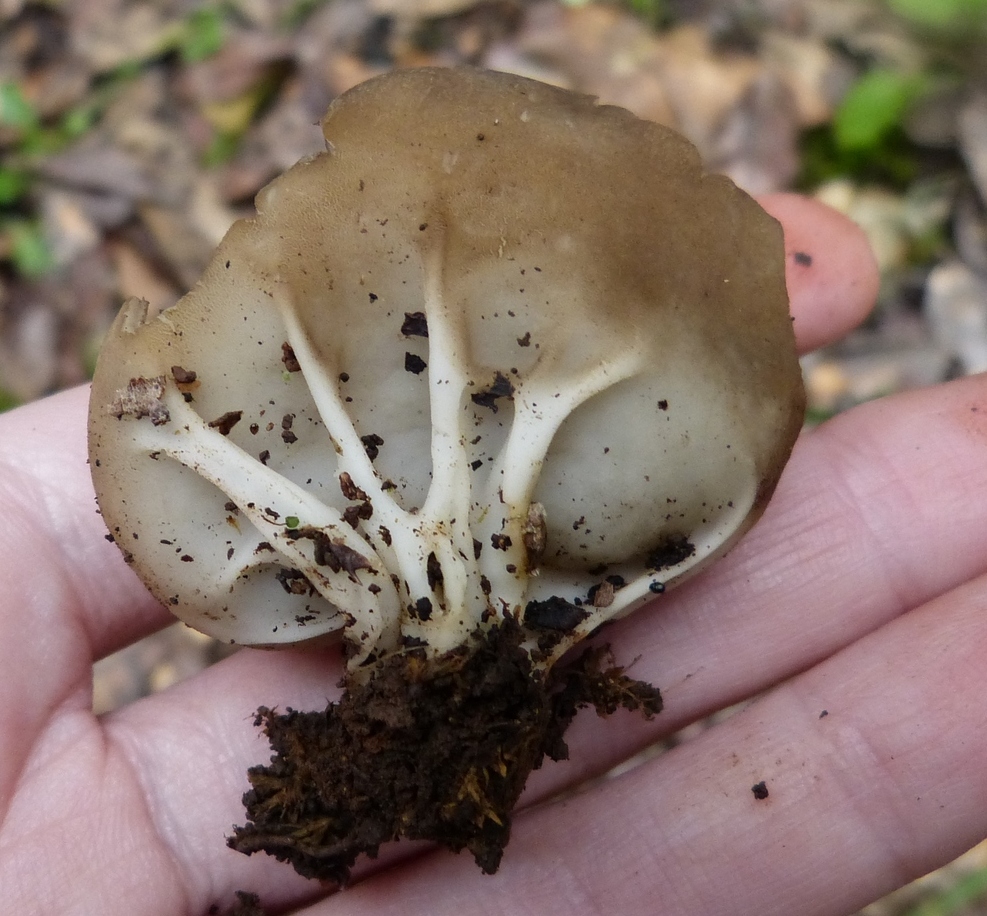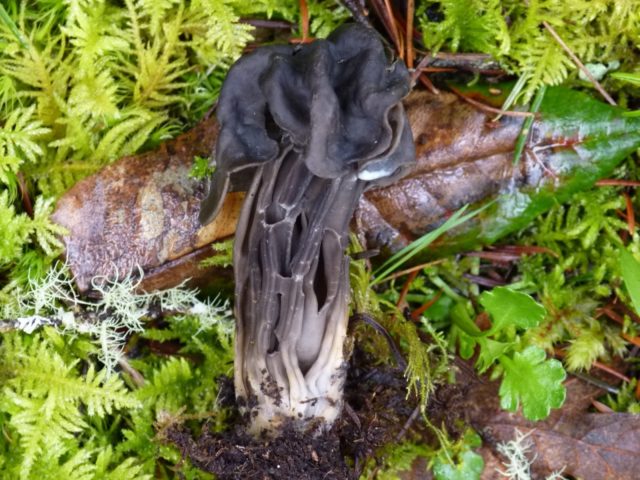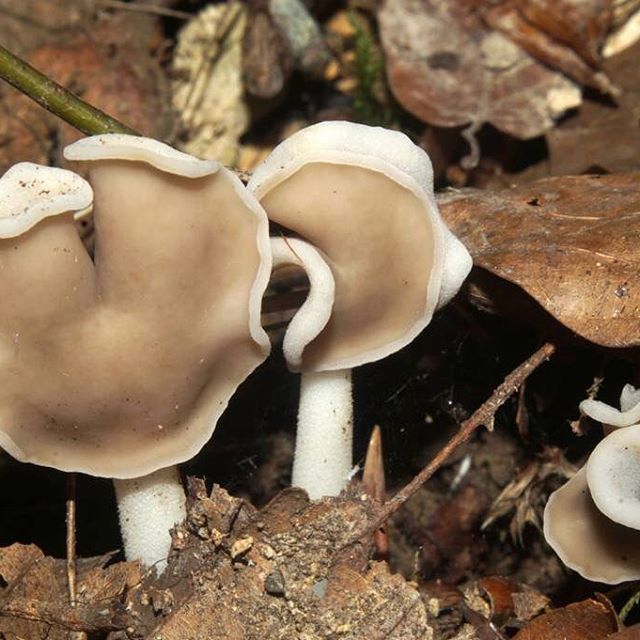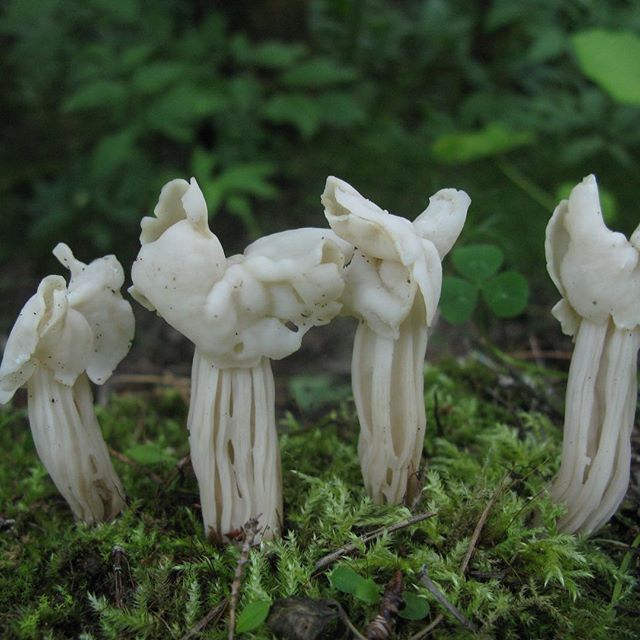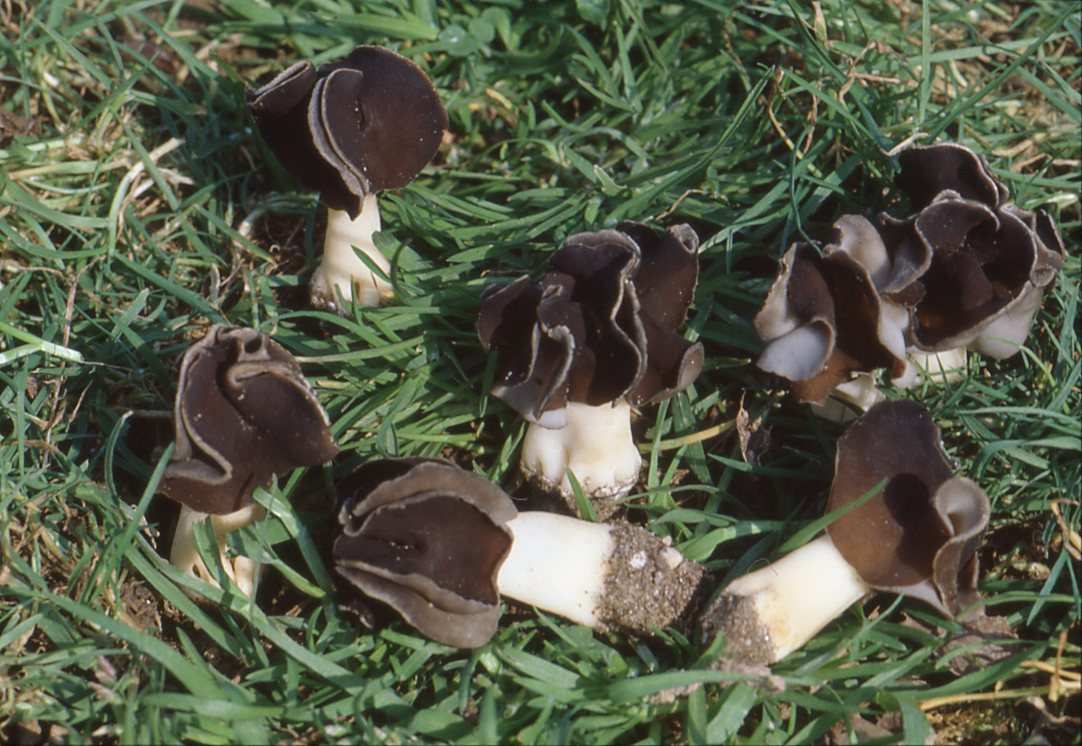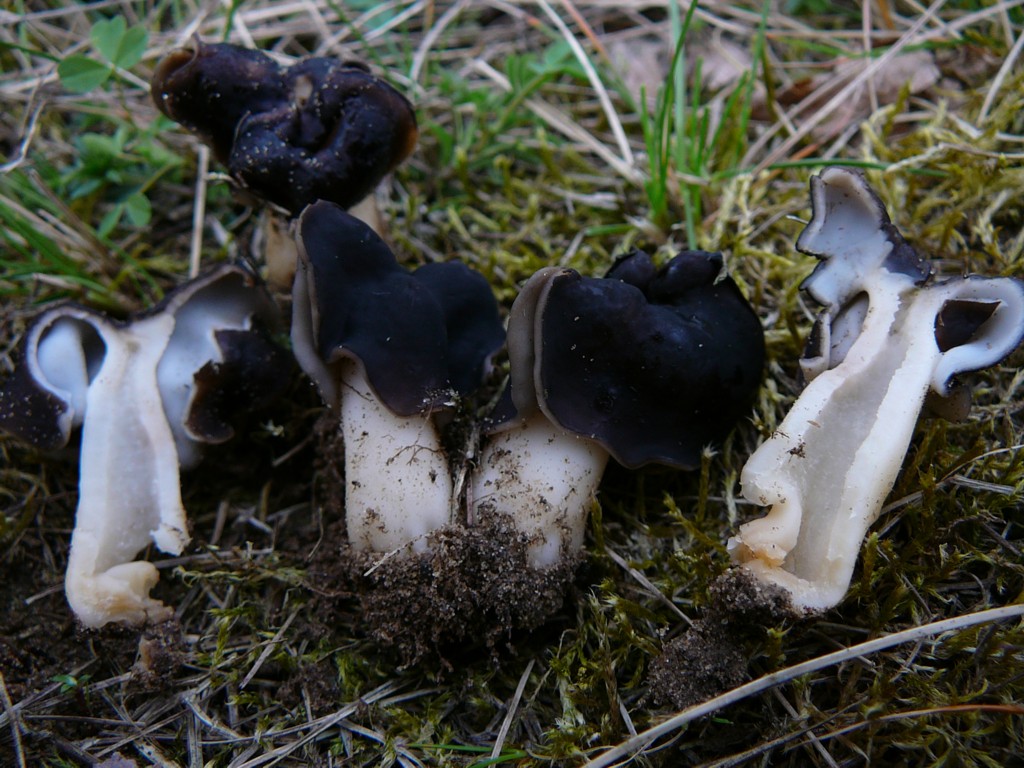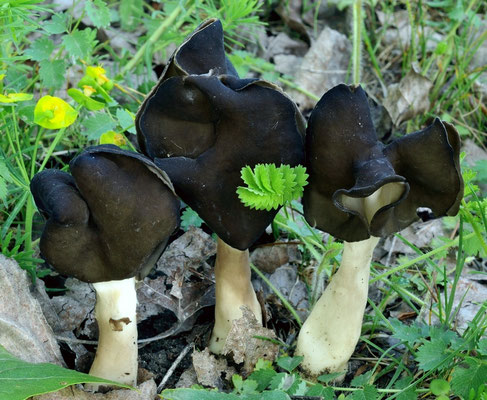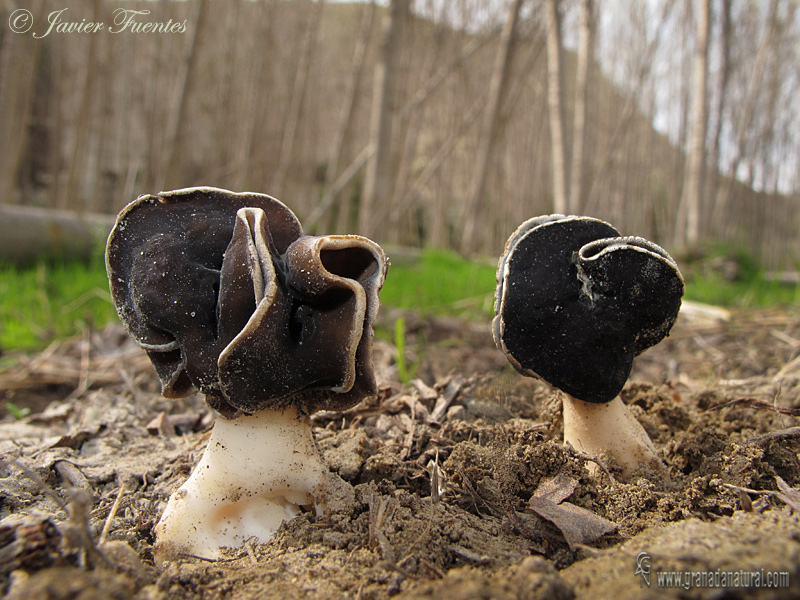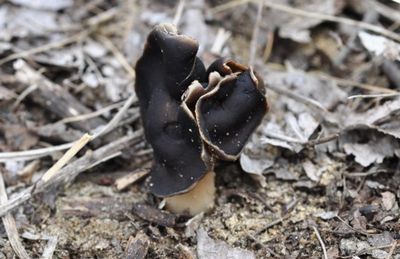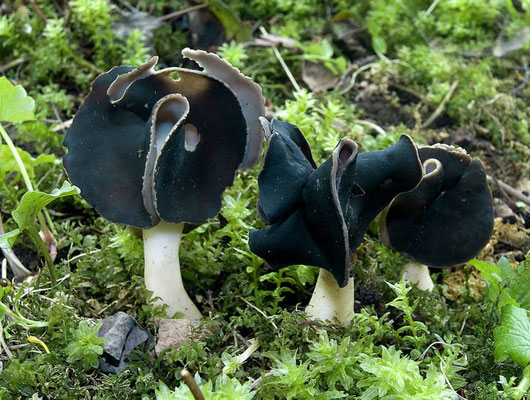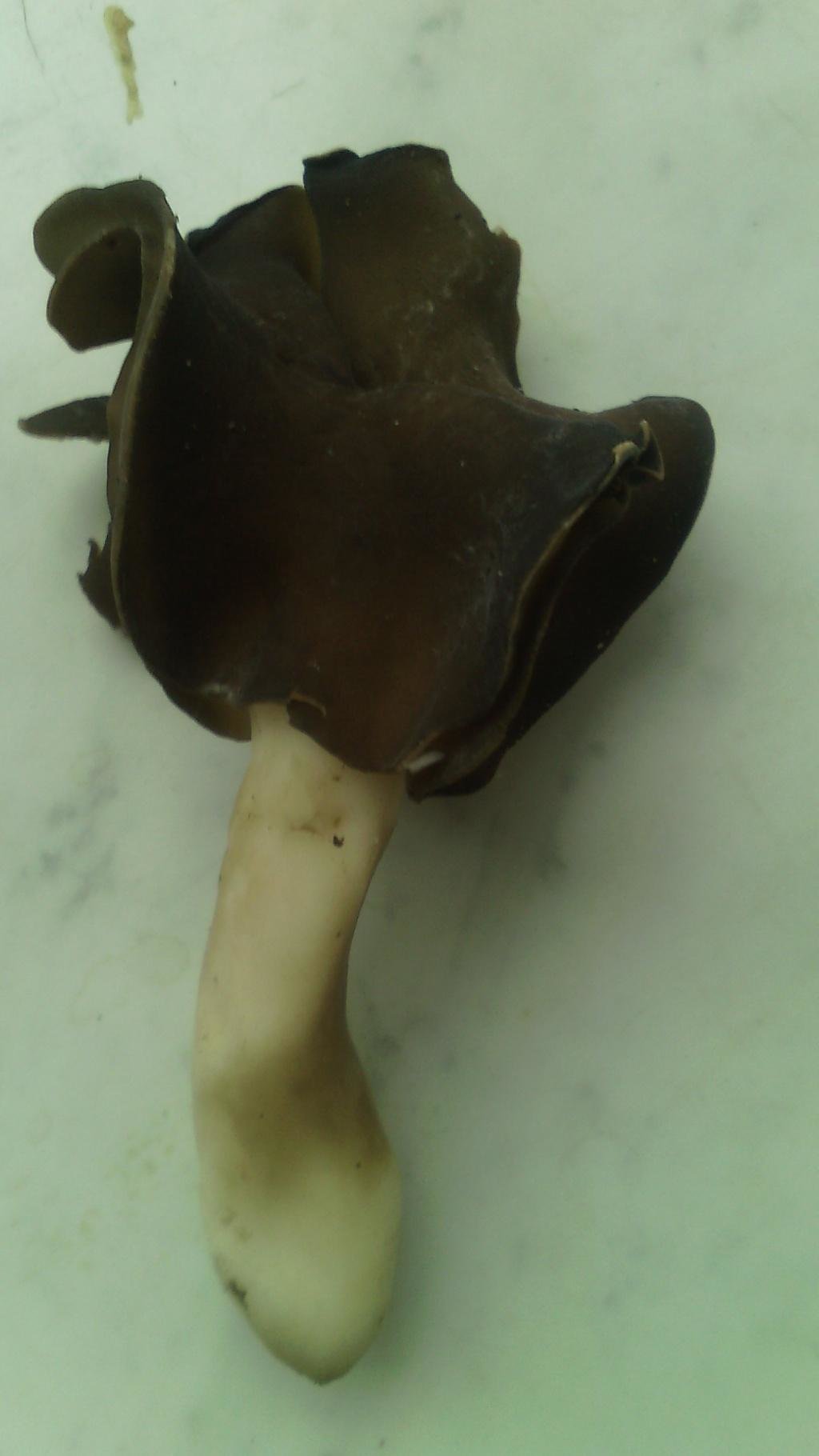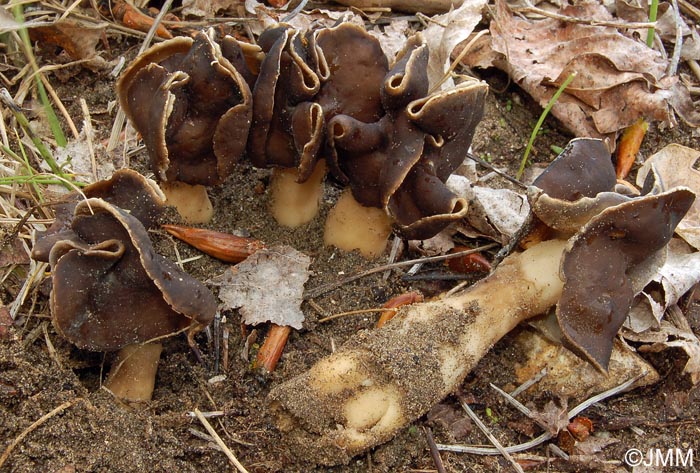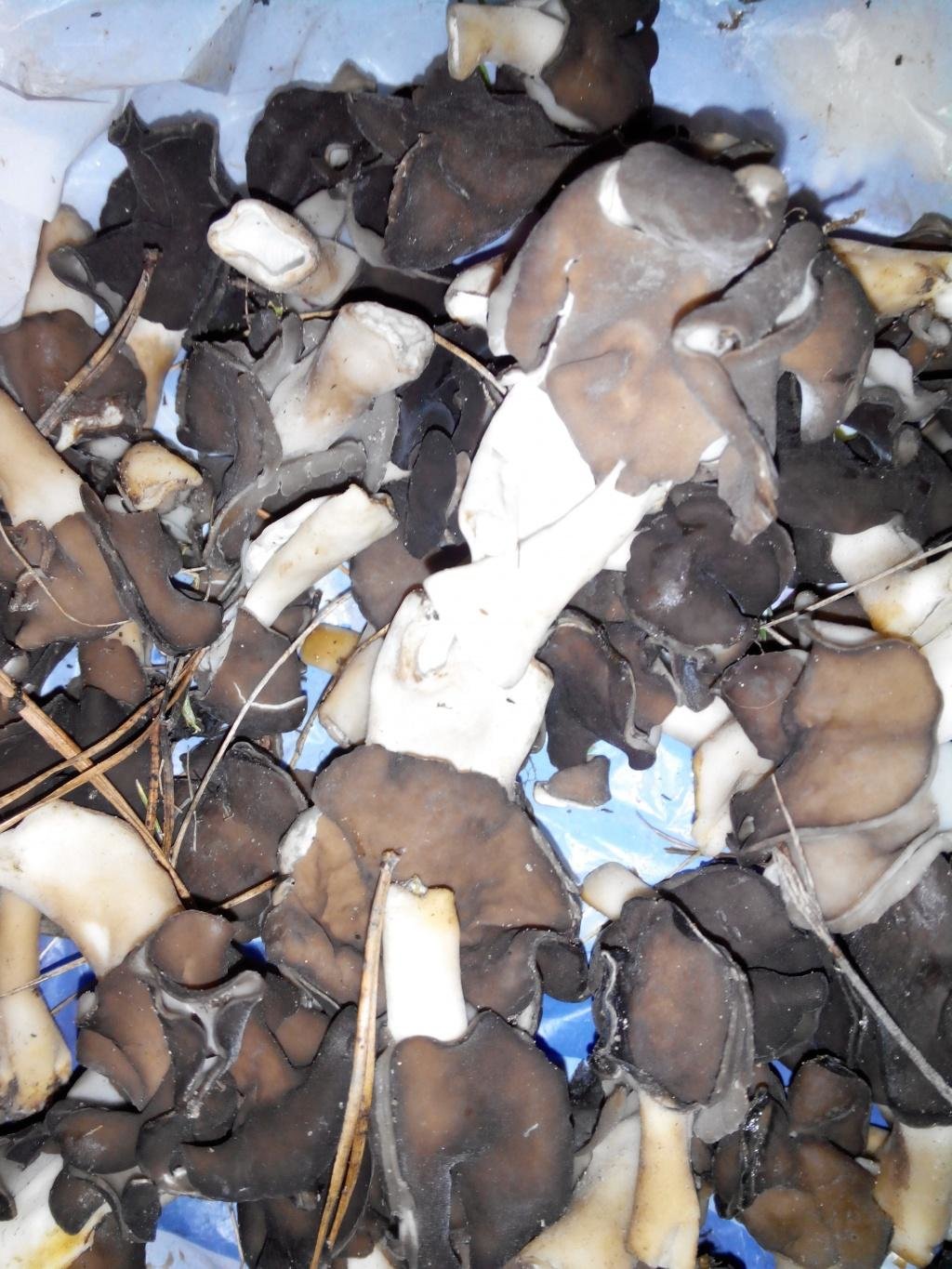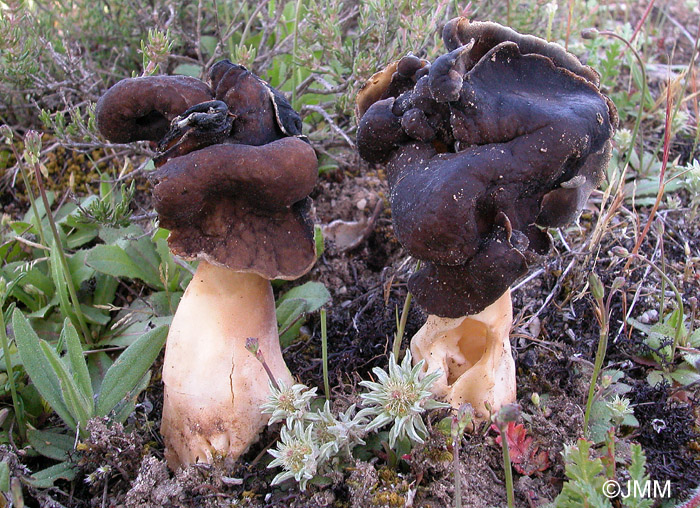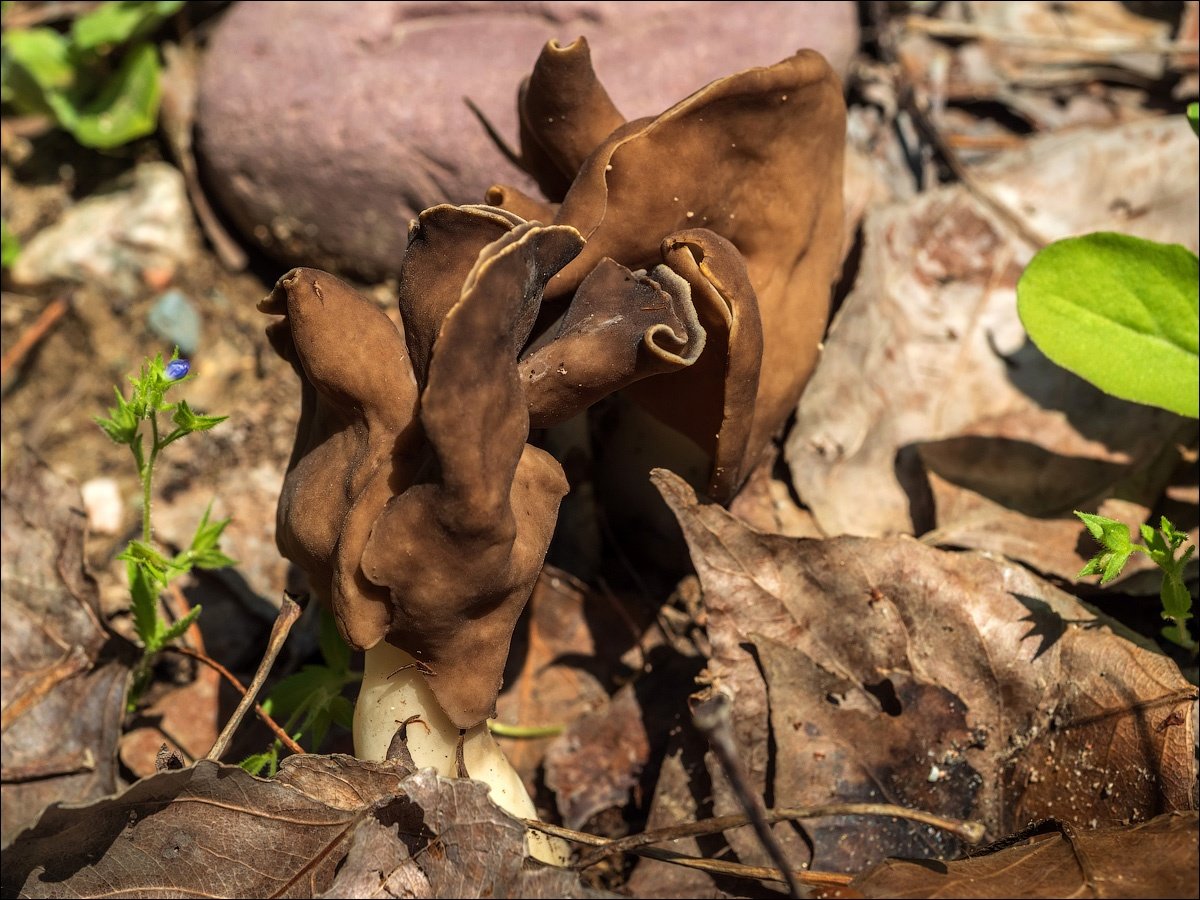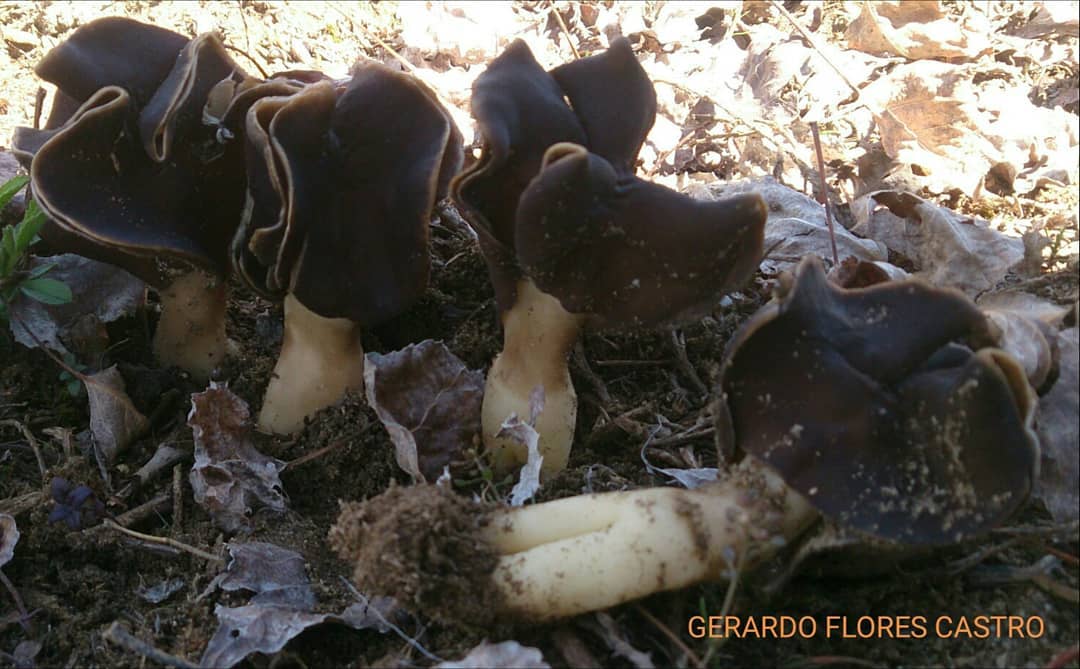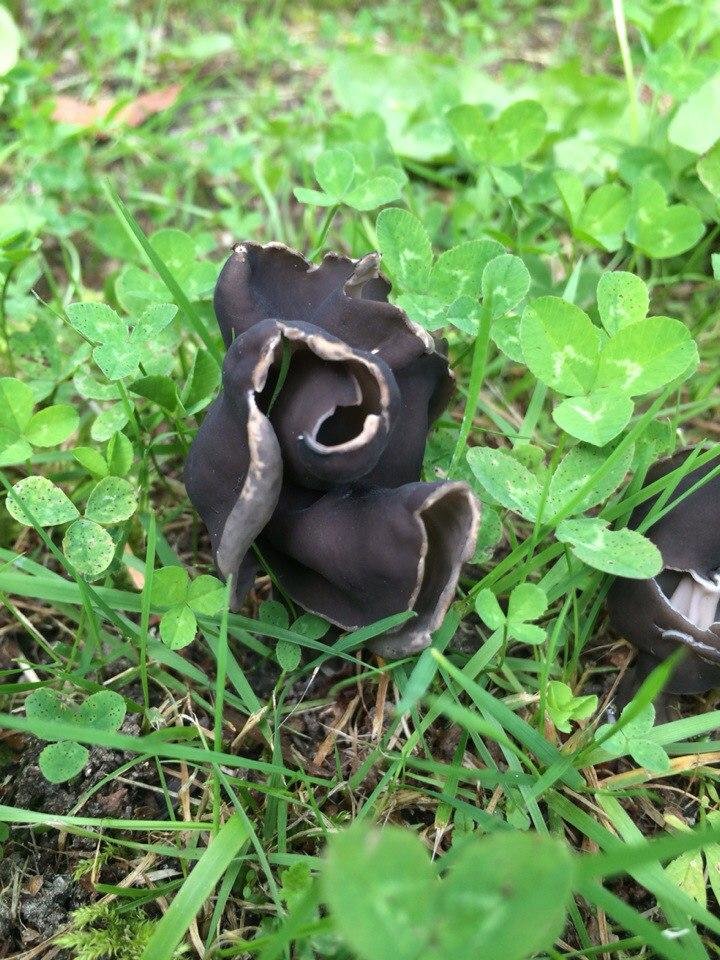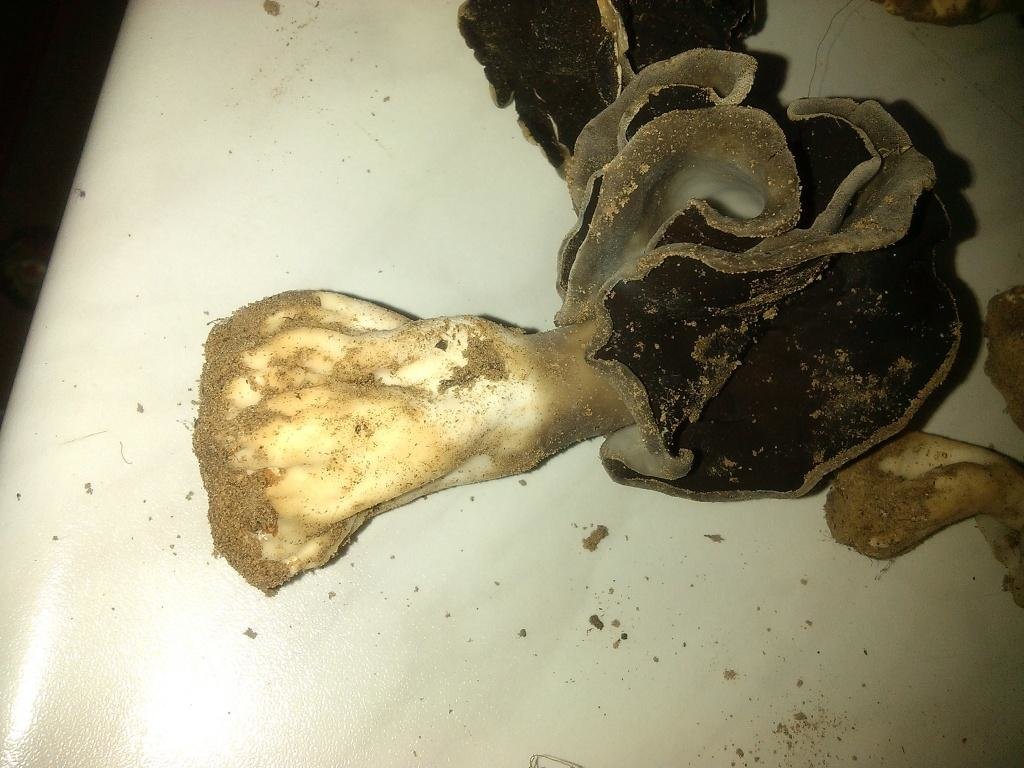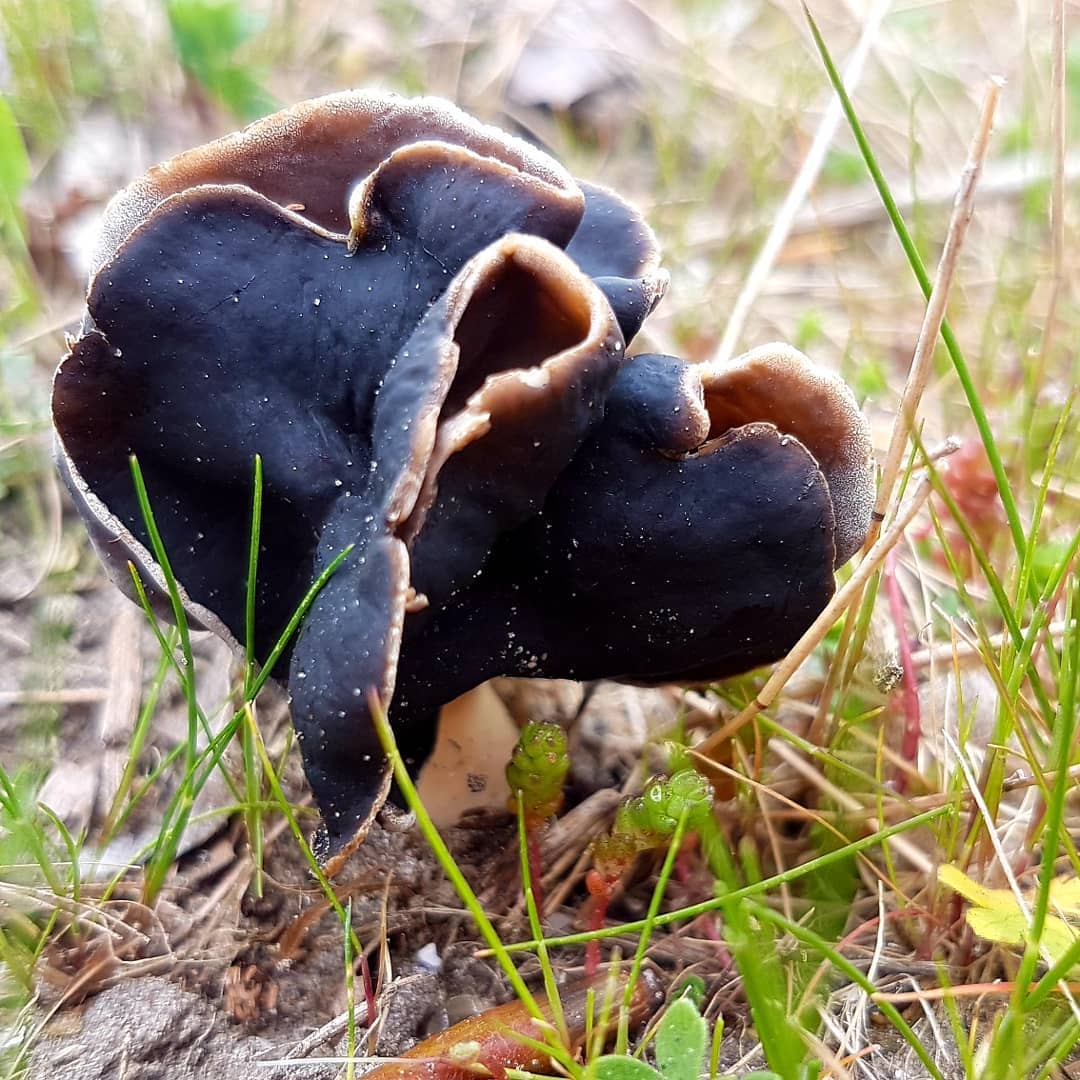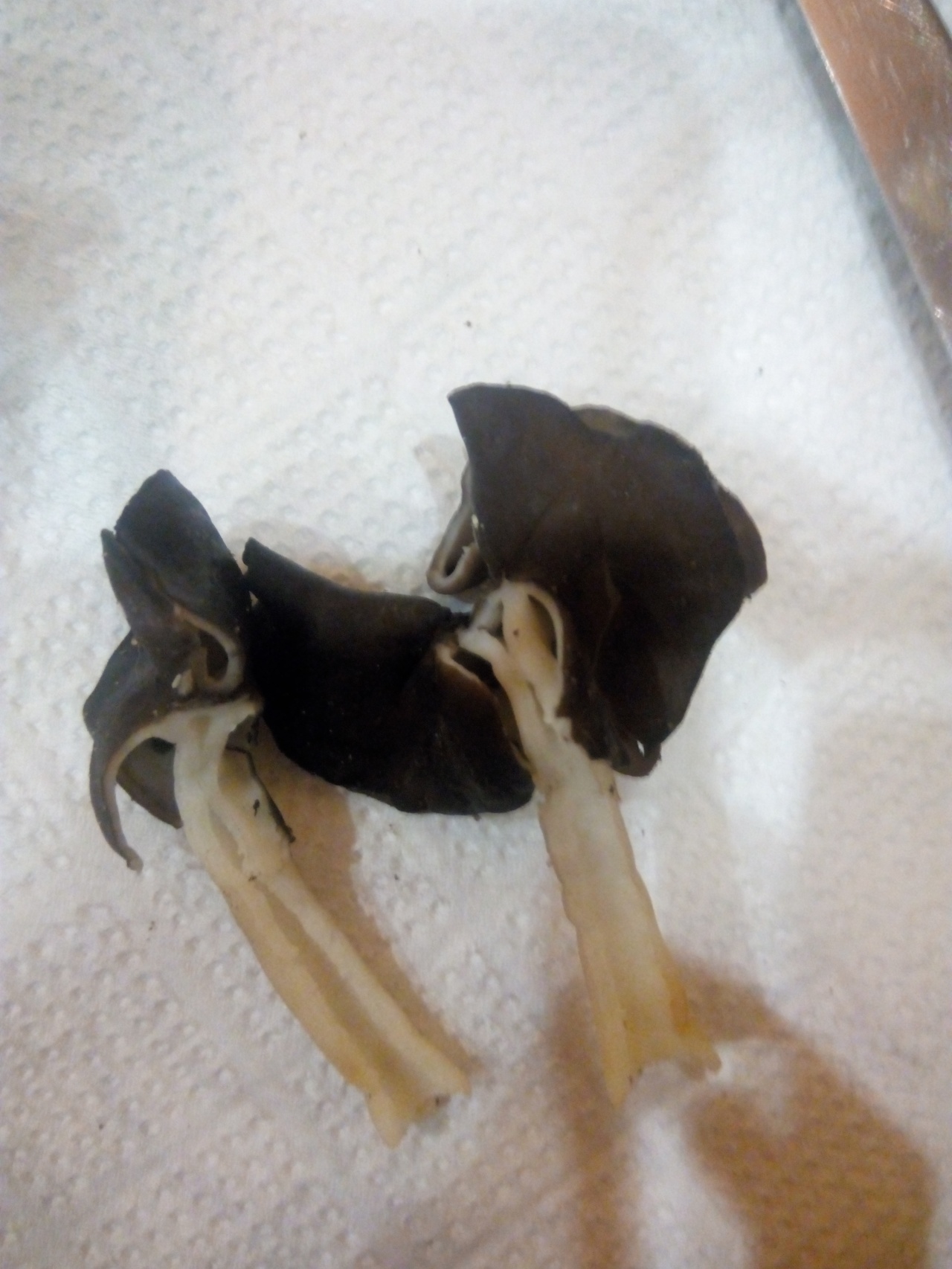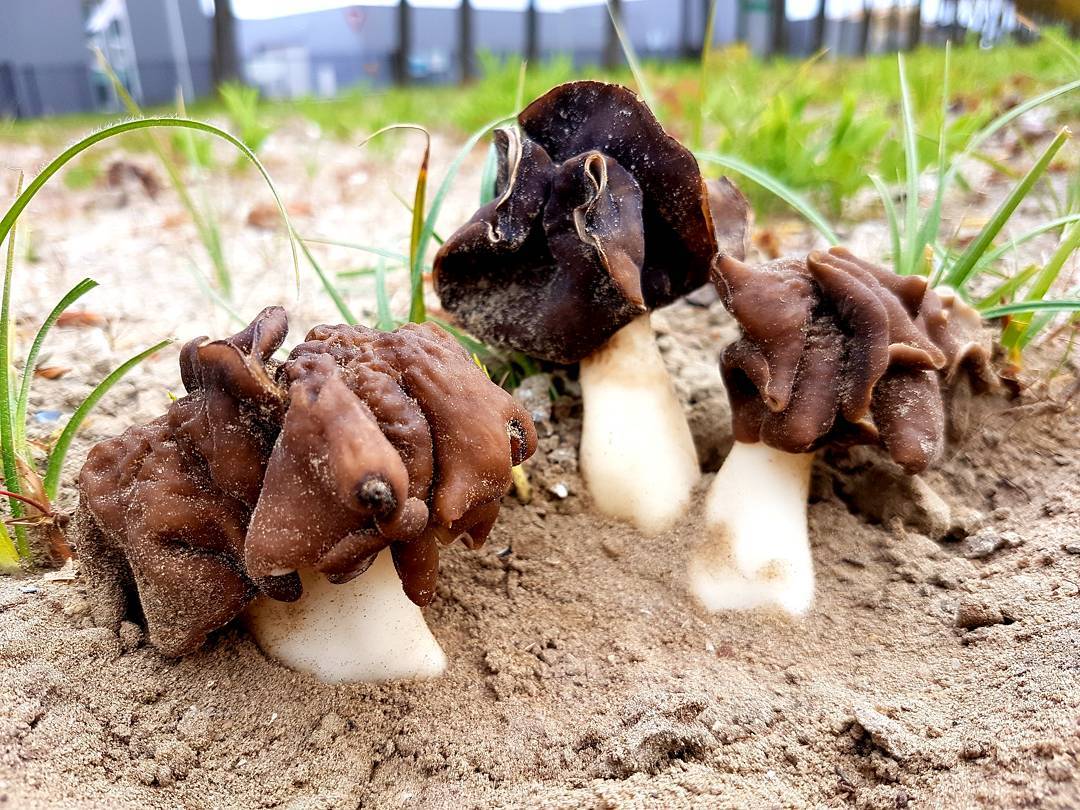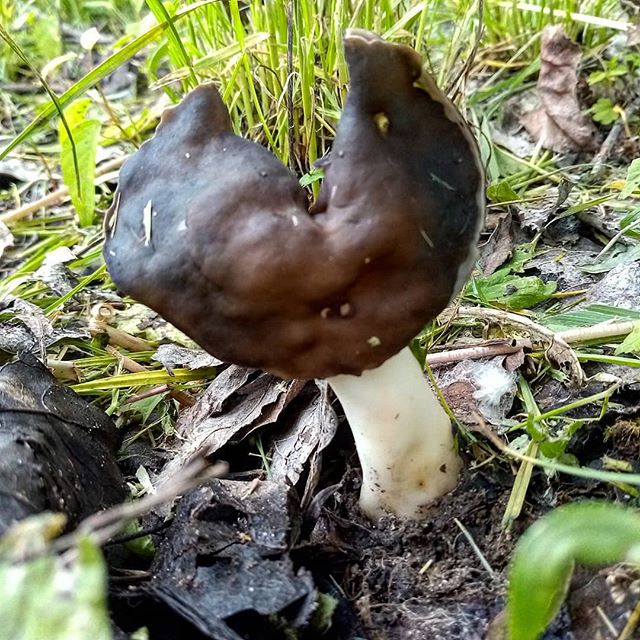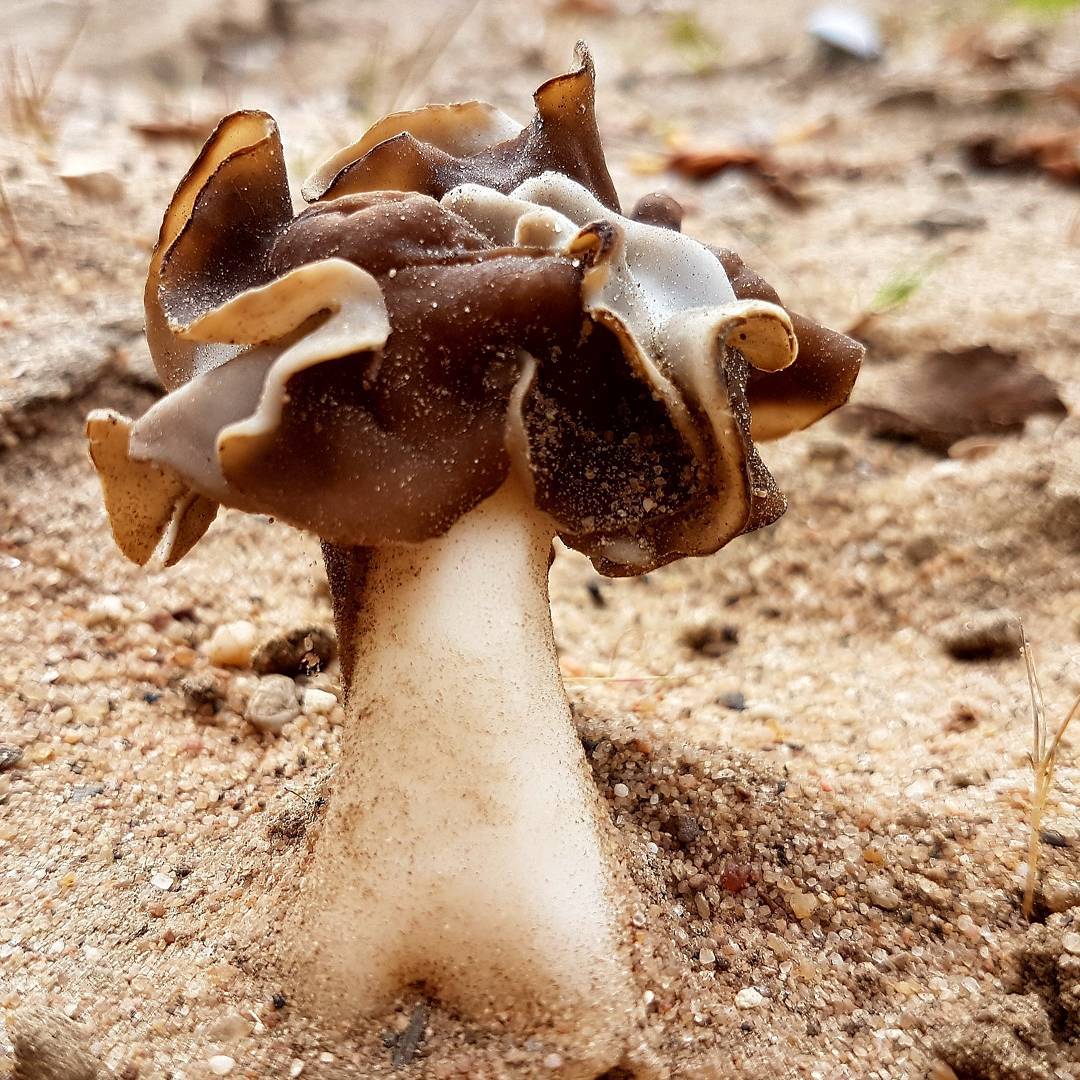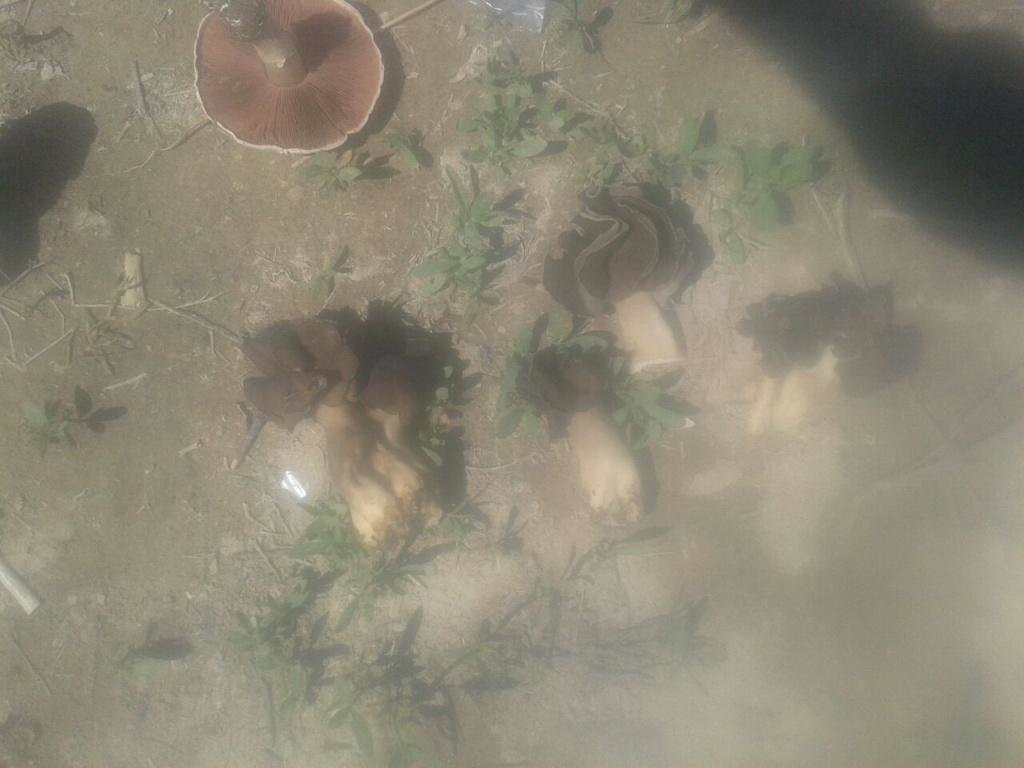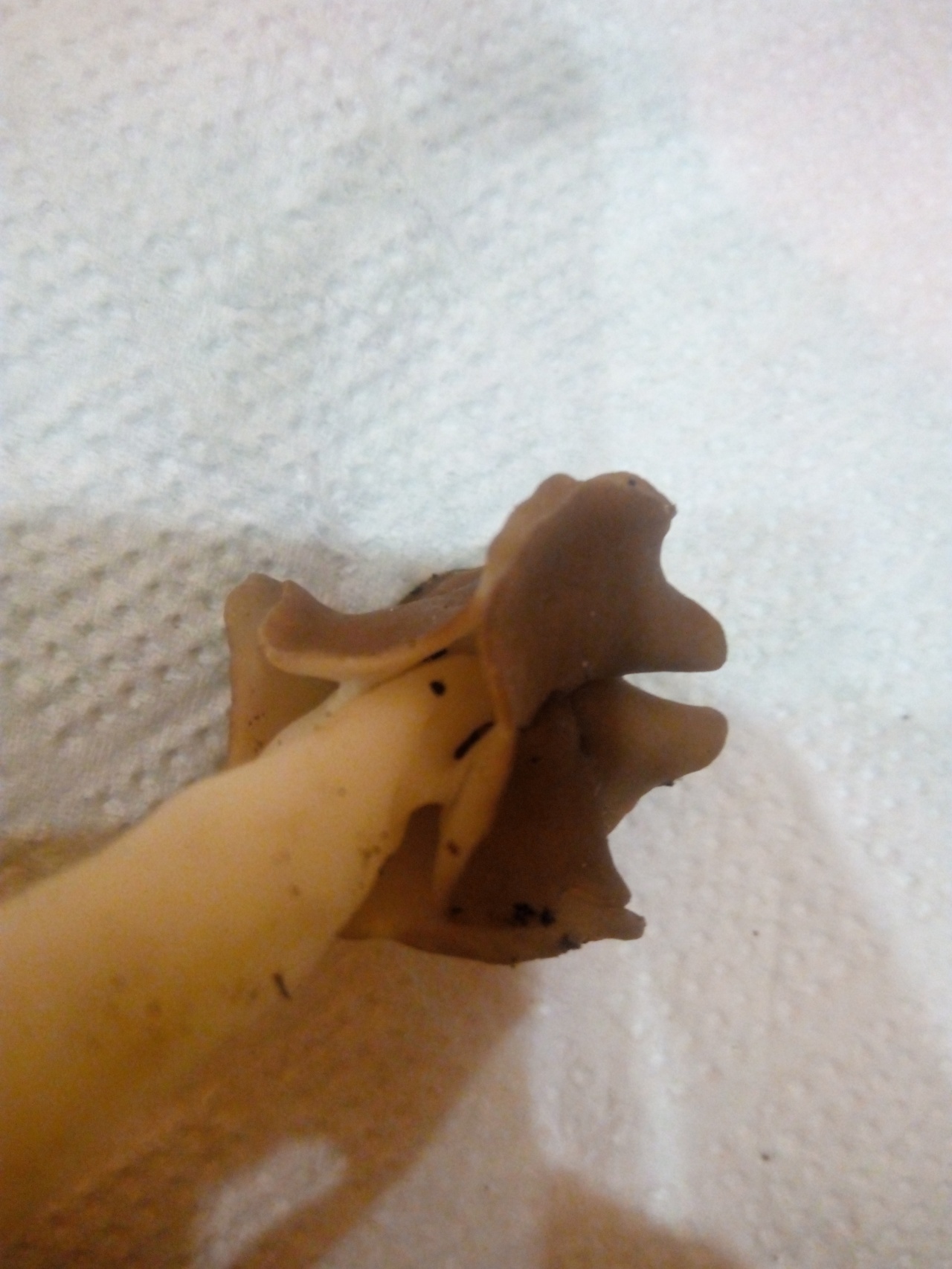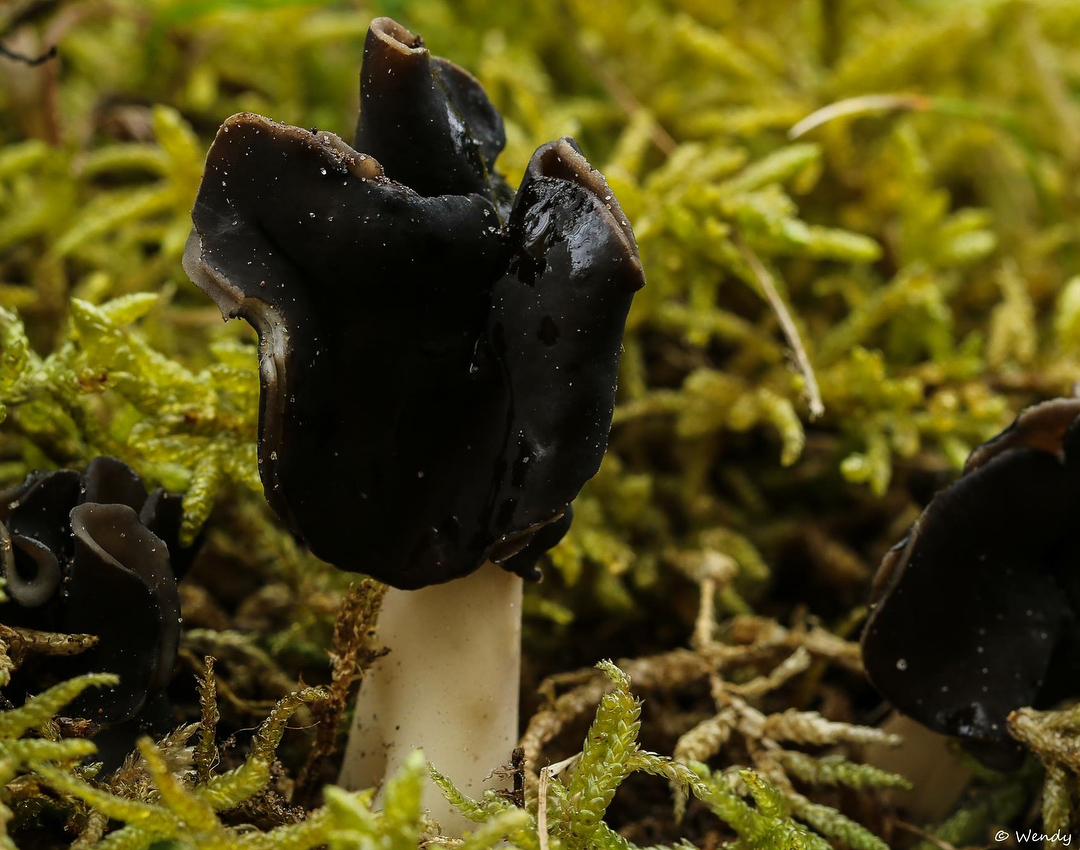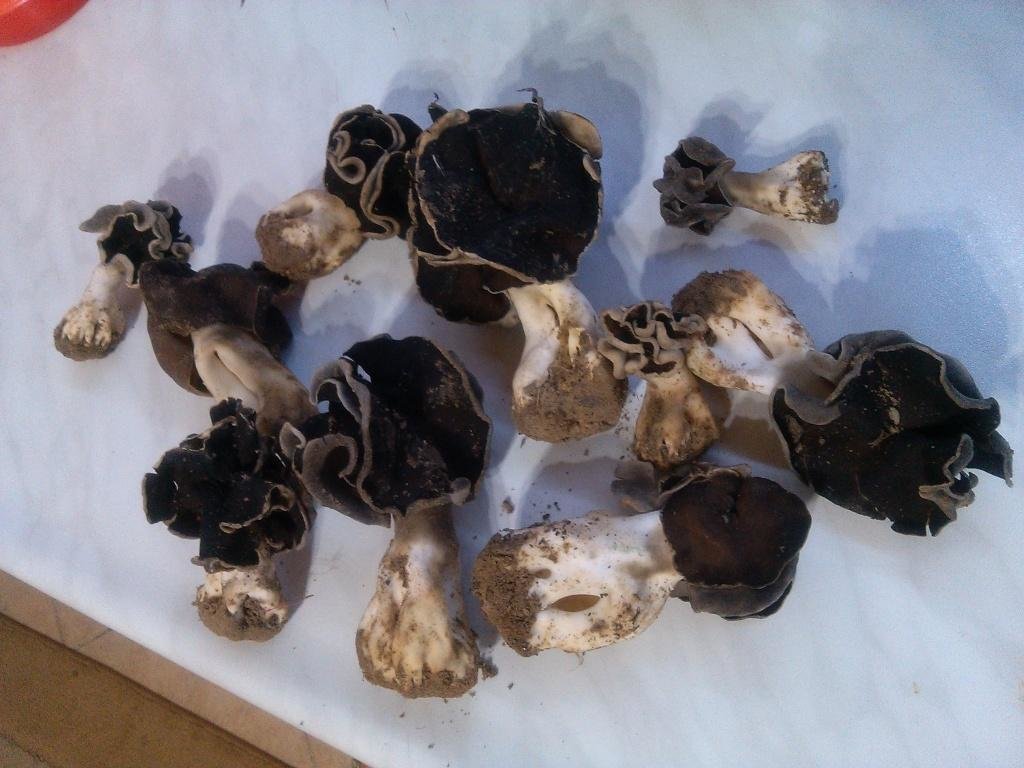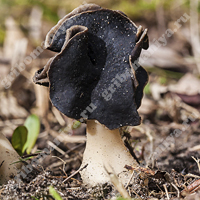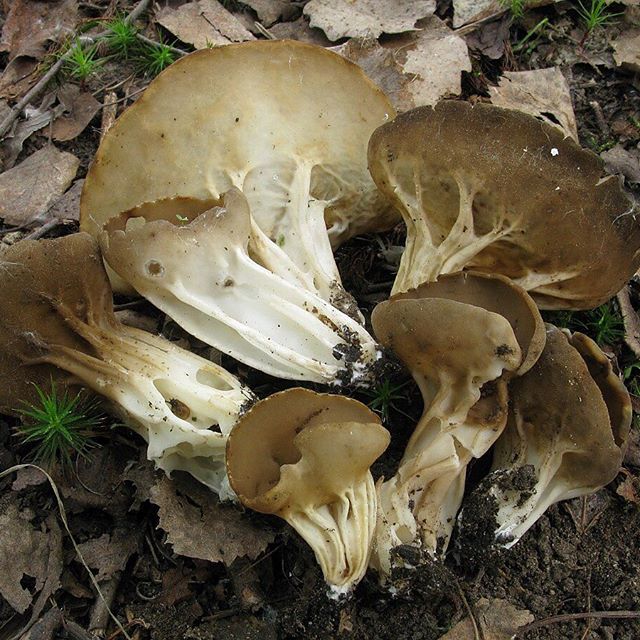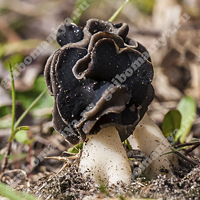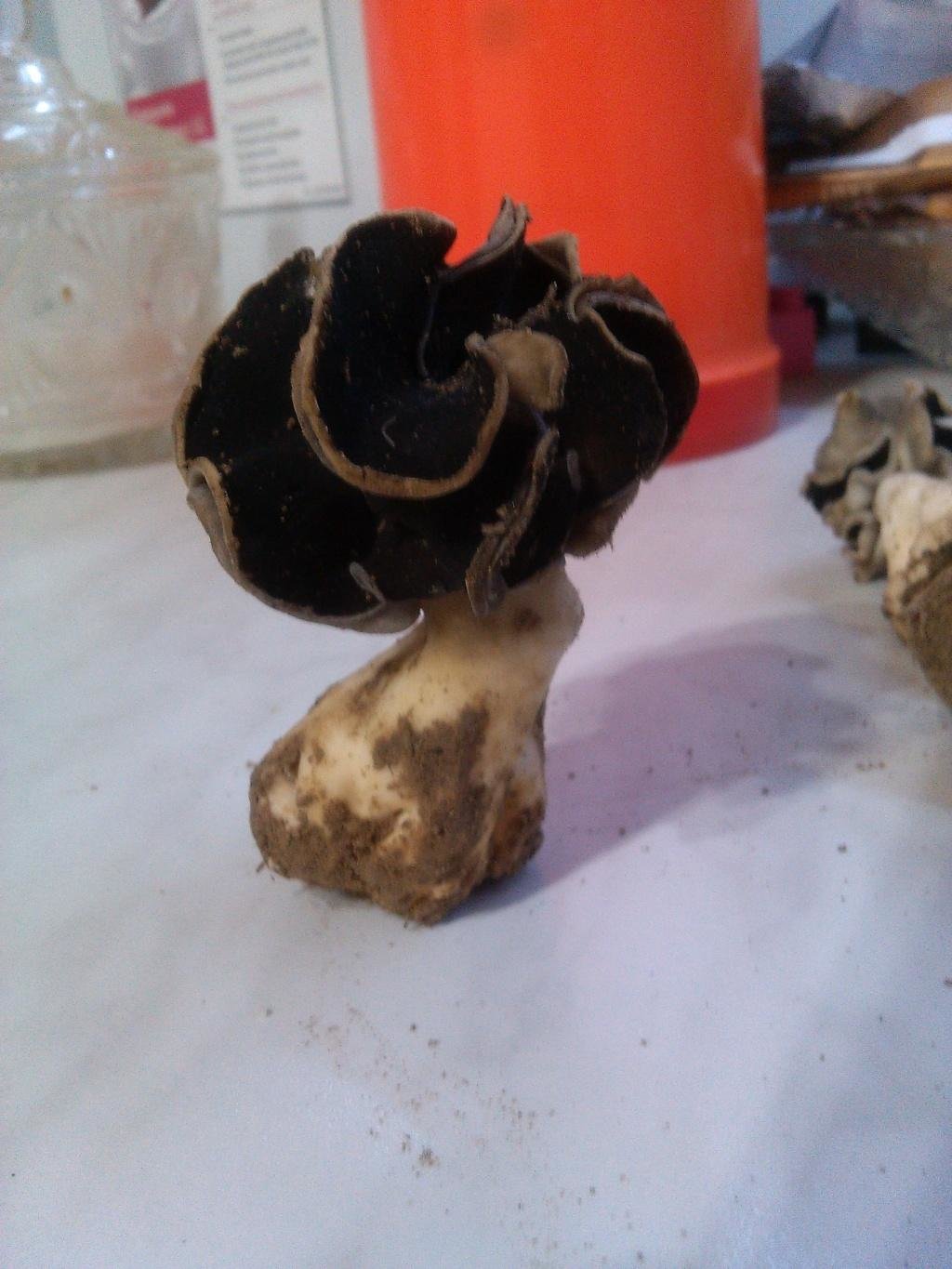Edible mushrooms, berries, herbs
Curly loafer (helvella crispa)
From May to early June and from mid-August to October in deciduous, coniferous and mixed forests, near bushes, along paths and roads, you can meet a mushroom from the Helwell family - curly lobster (curly helvella). The fungus has an irregularly shaped fruiting body with a notched ribbed stem. Grows in groups, rarely singly. preferring the grass cover.
The hat is from 1.5 to 4.5 cm in diameter, two- or four-bladed, usually curved. The edges are wavy-curly, free, adherent in places. The color is light yellow or ocher.
The leg is pitted-furrowed, fusiform, slightly widened towards the base, light white, hollow inside.
The pulp is thin, brittle, whitish, practically odorless.
The mushroom is edible and has low taste and organoleptic qualities. Edible after pre-cooking for at least 12 minutes. In addition to cooking, you can also dry it.
Photos of curly lobe (helvella crispa)



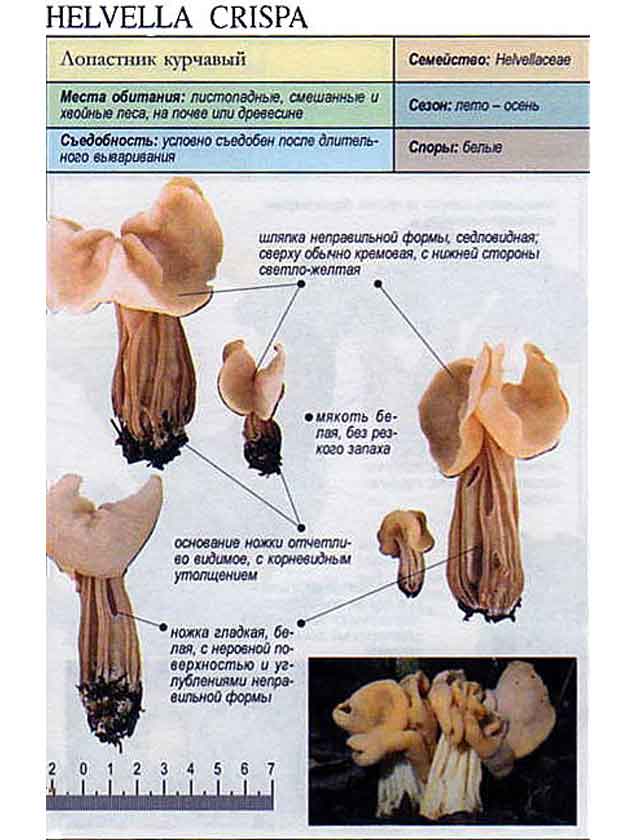
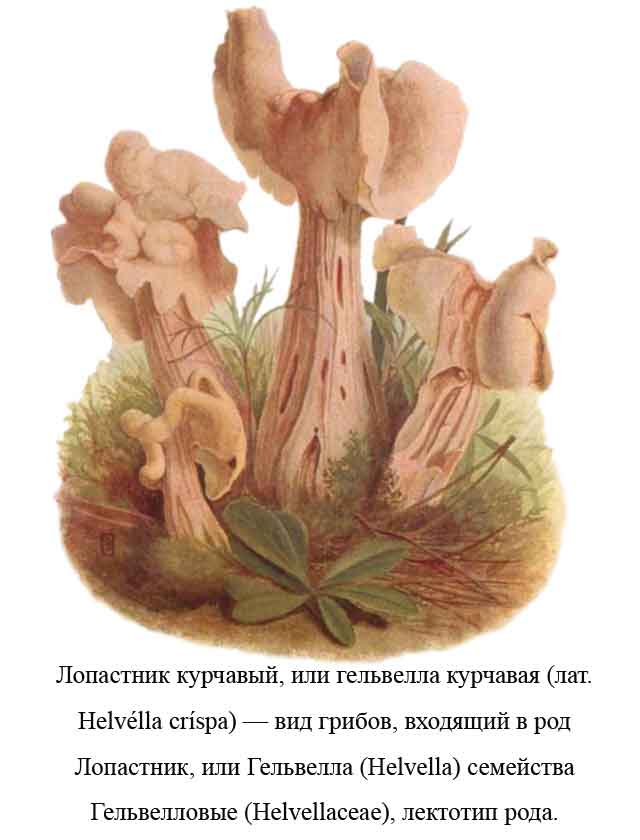
Video about how and in what conditions curly lobes grow, how these mushrooms look in natural conditions
The collected impressive volume of Ivan-tea raw materials or limited free time (sometimes all together) do not allow making Koporye tea by hand using traditional technology. Modern means come to our aid, one of which is a simple electric meat grinder. Tea made in this way is obtained in granular form. (more)
Already in April, delicious gourmet spring mushrooms - morels, represented by three main types: real morel, conical morel, morel cap - begin to grow en masse. Giant and ordinary lines can often be found next to morels. For lovers of exotic dishes, the spring forest also offers the most beautiful sarkoscifs, miniature strobiliurus, and a variety of saucers. In May, the species composition increases significantly: various horned beetles, dung beetles, tinder fungi, champignons, raincoats, May ryadovki, entolomy, pecicia, and spring mushrooms are added.
Edible mushrooms of an unusual shape, found in the European part of Russia, Belarus, Ukraine, Kazakhstan, Germany, have been added to the catalog:
Areas of growth of curly lobes.
Curly lobster is a rare species, in our area it is extremely rare. Places of growth are coniferous and deciduous forests of Europe. Everywhere these mushrooms grow in small groups. They often settle along the edges of forest roads. Fruiting lobster curly from the beginning of August to the end of October.

Evaluation of the edibility of curly lobules.
All lobules are characterized by the content in the fruit bodies of a certain amount of toxins. Some species contain the dangerous toxin gyrometrin, while others contain muscarine, which are only partially removed from the fruiting bodies. Lopasnik curly belongs to the conditionally edible representatives of the mushroom kingdom, it is assigned the 4th category in terms of taste.

Although no cases of lobe poisoning have been reported, it is believed that the degree of poisoning depends on the frequency and amount of their use. That is why it is recommended to consider the curly loafer an inedible mushroom. It is not advisable to eat it. It is worth noting that it is not tasty, so it doesn't make sense to take risks.

Related species.
Lopate-lobe, like curly lobe, is a conditionally edible mushroom. The shape of its cap is saddle-shaped, it consists of 2-3 lobes. The upper part of the hat is gray or brown in color, and the lower part is lighter. The leg is grooved or folded, widened at the bottom. Lobules grow on soil, in groups in deciduous and coniferous forests. They bear fruit from summer to autumn.

Saucer lobe is another conditionally edible representative of the genus. This mushroom has a stem from which ribs branch out. The shape of the fruiting body is at first hemispherical, and then becomes goblet. The inner part of the fruiting body is dark brown or brown, and the outer part is lighter. The leg is strong, short, whitish in color. The pulp is tough, without a pronounced taste.

Goblet lobes bear fruit from May to June. You can find them on paths and various slopes of coniferous and deciduous forests. This species is not common.
Curly Lobster (Helvella crispa)
or
Helvella curly
Curly loafer, or Helvella crispa (lat.Helvella crispa) is a species of mushrooms belonging to the genus Lostnik, or Helvella, of the Helvellaceae family, a lectotype of the genus.
Curly loafer, among the inhabitants of the forest, is one of the few representatives of mushrooms, the Helwell family. And the word Helwella, literally translated from Latin, means: "small vegetable", "greens" or "cabbage" and, in the best possible way, characterizes the very essence of this mushroom. In Russia, the genus Helwell is called differently, they are called blades, because of the characteristic structure of their cap in the form of a propeller blade. This is especially evident in other types of helwell. In total, there are 25 species of such mushrooms and 9 of them grow in Russia. And curly lobe, among all lobules, is not the most common mushroom. A characteristic feature of all blades (helwell) is the content of a certain amount of toxins in their composition. Some of them contain the heavy toxin gyrometrin, while others contain muscarine, which can be removed from them only partially and only during the drying process. Curly lobster, as well as common lobster, is considered by some sources to be a conditionally edible mushroom with the taste of mushrooms of the fourth category. This is partly so, but ... and not so. Cases of poisoning with lobules have not yet been recorded, and the degree of poisoning with them directly depends on the number and frequency of their use. It is for this reason that curly lobe (or curly helwell) is best considered an inedible mushroom. And, therefore, it is highly undesirable to use it in food. Yes, and it is extremely rare in our area, and the taste is not at all tasty.
Curly loafer is a rather rare mushroom. And the main places of its growth can be considered deciduous and coniferous forests of Europe and the European part of Russia, in which it is found in small groups, often along forest roads and, unlike the common lobster (Helwella vulgaris), it grows not in spring, but in autumn - from the beginning of August to the end of October.
Curly loafer belongs to marsupial mushrooms, that is, its spores are located in the very body of the mushroom in the so-called "bag". His cap is folded, two to four lobed, irregular and incomprehensible in shape, with wavy or curly edges hanging down and, only in places, growing to the stem. The color of his cap is from waxy beige to pale ocher. The stem of the fungus is short, straight or slightly curved, slightly swollen at the base, with deep longitudinal grooves or folds, it is hollow inside. The color of the leg is white or ash gray. The flesh of the mushroom is thin and very brittle, waxy white in color, with a pleasant mushroom smell. But, all the same, it is not worth trying in the forest to taste curly lobe in its "raw" form!
Curly loafer - refers to conditionally edible mushrooms. (4th category)
Black loafer: photo and description
| Name: | Black lobe |
| Latin name: | Helvella atra |
| Type of: | Inedible |
| Specifications: |
|
| Systematics: |
|
Black lobster (Helvella atra) is a mushroom with an original appearance, belonging to the Helwell family, from the Lobster genus. Other scientific name: Black leptopodia.
Black lobe is extremely rare in our forests.
What does a black paddle look like
Only the fruiting bodies that have appeared have the appearance of a kind of saddle on a pedicle or a fractured disc. The hat has a rounded centerline fold, whose outer corners are noticeably raised above the horizontal. The halves of the cap are strongly lowered down almost in a straight line or slightly rounded inward, the edge is often accreted to the stem. As it develops, the surface bends in bizarre waves, changes to shapeless lumpy. The edges can be noticeably turned outward, exposing the inner surface, or, conversely, hug the leg with a kind of cape.
The surface is matt, dry, slightly velvety. Gray to dark gray with brown or bluish tinge and shapeless blue and black spots. The color may darken to brownish black. Inner surface, hymenium, smooth or slightly wrinkled, with pronounced bristles, brownish or gray in color. The pulp is brittle, loose, tasteless. Its color is transparent gray, like wax. The diameter can be from 0.8 to 3.2 cm. The spore powder is white.
The leg is cylindrical, expanding towards the root. Dry, pubescent in the upper part, with longitudinal stripes. The color is uneven, noticeably lighter at the base. Color from beige, gray-cream to dirty bluish and ocher-black. The length is from 2.5 to 5.5 cm, the diameter is 0.4-1.2 cm.
Legs are often crooked, with shapeless dents
Where do black blades grow
Distributed in Japan and China, where it was first found and described. Then it was discovered on the American continent and in other regions of Eurasia. It is extremely rare in Russia, and it is a great success to see it.
Prefers deciduous forests, birch forests. Sometimes its colonies are found in pine forests, spruce forests. It grows in large and small groups, with loosely located individual mushrooms. Loves dry places, sandy soils, grassy meadows in gardens and parks. The mycelium bears fruit from June to October.
The black lobe feels great on rocky areas.
Is it possible to eat black blades
Black lobster is classified as an inedible mushroom due to its low nutritional value. There is no scientific data on its toxicity. It can be confused with other members of the Helwell species.
Lobules are pitched. Inedible. It has a larger size, fleshy thick leg.
The legs of these fruiting bodies have a characteristic cellular shape.
Lobule petsytsevidny. Inedible. It differs in a noticeably upward-curled edge of the cap.
The flesh of the cap is so thin that it shines through
White-legged lobe. Inedible, toxic. It has a pure white or yellowish stem, a light hymenium coloration and a blue-black cap.
Conclusion
Black lobster is an interesting rare mushroom from the Helwell family, a fairly close relative of pets. Inedible, according to some reports, toxic. It has an extremely low nutritional value, so you shouldn't risk your health. In Russia, several colonies of this fungus have been found in the region of Novosibirsk. Its habitat is China, Europe, North and South America. Grows in deciduous, sometimes coniferous forests from early June to mid-October.
Curly loafer: description and photo
| Name: | Curly loafer |
| Latin name: | Helvella crispa |
| Type of: | Conditionally edible |
| Synonyms: | Curly Gelwell. |
| Specifications: | |
| Systematics: |
|
Curly Helvella, curly lobe or Helvella crispa is a mushroom of the Helwell family. Rare, autumn fruiting.The nutritional value is low, the species belongs to the last fourth group.
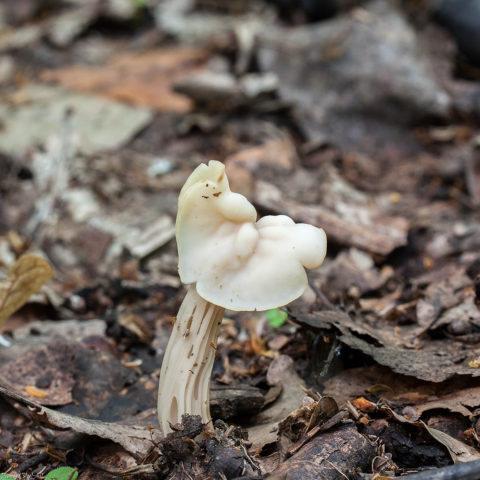
The lobe has an unusual structure of the leg and cap.
What do curly paddles look like?
The mushroom is medium in size, growing up to 10-12 cm in height without a definite shape of the upper part. A marsupial species, spores are formed not on the surface of the cap, but in the fruiting body.
- Apothecium of irregular saddle shape, divided into several lobes.
- The upper part of young mushrooms with concave, relatively smooth edges, over time, the cap straightens, becomes shapeless, the edges hanging wavy or curly.
- The cap is loosely attached to the stem in the center, the surface is folded, small tuberous or wrinkled. Coloring is monochromatic, light cream or beige. The protective film is smooth matte.
- The lower part with a fine, sparse edge, one tone darker than the upper surface.
- The pulp is thin, fragile, light beige with a pleasant smell.
- The leg is often straight, can be curved in the upper part, fusiform, thickened at the base, 3 cm wide.
- The surface is ribbed with deep grooves, longitudinal stripes covering the underside of the cap.
- The color is white or light ash.
The structure of the stem is hollow, fibrous and brittle. In overripe specimens, it is tough.
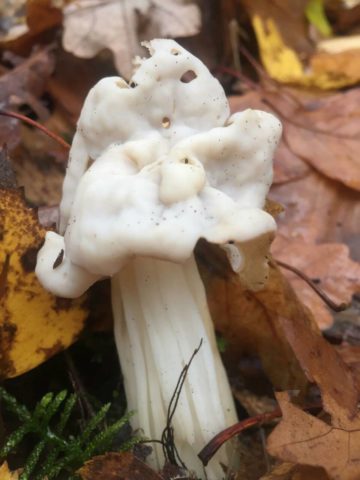
The edges of the cap may be strongly raised or clearly concave
Where curly lobes grow
The species is not widespread, it is rare. In Russia, the main cluster is in the European part. It grows in open areas: forest glades, glades, near roads. The mycelium is located among low grass, coniferous or leaf litter. Occurs singly or in small groups from the end of August in all types of forests.
Is it possible to eat curly lobes
The species is rare and completely unexplored, but many specimens contain muscarine in the fruiting body. A natural alkaloid is a part of many poisonous mushrooms and causes varying degrees of intoxication. Partially decomposes on drying or heat treatment.
Because of its rarity, there have been no cases of poisoning with curly lobe, and besides, it is not used in large quantities. Fruiting bodies with low nutritional value are referred to the conditionally edible group. Eating is possible only after boiling. In the autumn, other types of edible mushrooms bear fruit, so it is better not to take the lobster.
False doubles
False twins of helwella curly include an elastic lobe. The mushroom is quite common. Fruiting profusely from mid-July. It is found in all types of young and old forests, prefers well-humid shaded areas. Belongs to the fourth category, conditionally edible species. The fruiting body is tasteless and odorless.

The vane's cap is elastic with smooth edges and a light brown surface
Collection rules
The main time for collecting curly lobe is mid-September. It is not recommended to take crops in an environmentally unfavorable zone: near chemical plants, gas stations, along the sides of highways, city dumps.
Conclusion
Lobules curly without taste and pronounced odor, is not of gastronomic interest. The species is classified as conditionally edible. Fruiting in autumn, use is possible only after boiling.
Scooper vane: description and photo
| Name: | Goblet vane |
| Latin name: | Helvella acetabulum |
| Type of: | Conditionally edible |
| Synonyms: | Helvella goblet, Paxina acetabulum, Paxina acetabulum, Common Lobster, Helvella vulgaris, Acetabula vulgaris |
| Specifications: |
|
| Systematics: |
|
The goblet lobe is a representative of the genus of the same name, the Helvellaceae family.Other names are Helwella cublet or Acetabula ordinary. The mushroom belongs to the conditionally edible category.
What do the goblet blades look like?
The diameter of the fruiting body is from 2 to 5 cm. The mushroom has a fleshy-leathery structure and a goblet shape, which gradually expands as it grows.

At the edges, the cap is often wavy or lobed
At the edges, the cap is often wavy or lobed
The inner surface is smooth to the touch, with a hymenial layer. Its color ranges from buffy brown to brown. The outer surface has a lighter color and a granular-fine-flaked rough structure.
The goblet lobe is distinguished by a thick, relatively long, wrinkled stem from 1 to 3 cm in height.
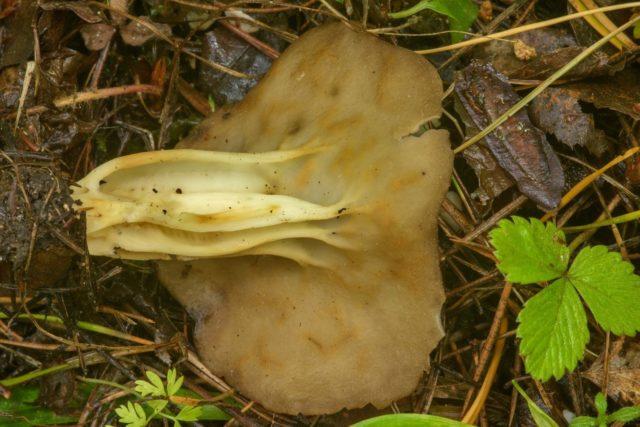
Inside, the leg is hollow, on the outer whitish tone of the part, ribbed longitudinal projections can be seen
The pulp of the mushroom has no characteristic taste and aroma, has a very thin and brittle structure. The size of colorless spores is 14-18 * 8-12 microns. With a characteristic oval smooth shape, they are arranged in one row.
You can learn more about the appearance of the mushroom in the video:
Where do goblet blades grow
Glacial lobes are quite rare, grow singly or in small colonies. Distributed in oak forests. The period of active fruiting begins in May and lasts until June. The main habitats are Europe, Asia and North America.
Is it possible to eat goblet blades
The species belongs to the conditionally edible group. Fruit bodies can only be eaten after preliminary heat treatment.
Almost all representatives of the Gelwell family are characterized by the content of toxic substances. In the composition of some species, such dangerous elements as gyrometrin or muscarine may be present, which are completely impossible to remove from the fruiting bodies.
False doubles
The main false twin of the species is Kele's lobe. It can be distinguished by its specific shape in the form of a bowl flattened on the sides and a developed leg.
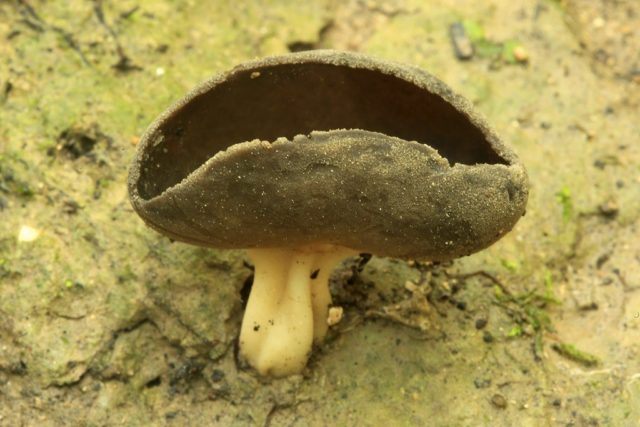
The outer surface of the cap is dark gray, yellowish gray, brown or brownish gray in color.
When the fungus dries, its color changes to a lighter one, a grayish or whitish granular plaque from conical bundles of short hairs appears on the surface. The inner part of the cap is smoother in structure, with a brown-gray, dark brown or completely black color.
Collection rules
Mushroom pickers recommend to bypass the shovel-shaped side due to the content of toxic substances in the composition and the low nutritional value of the mushroom. Even long-term heat treatment cannot guarantee getting rid of all poisons, because of which eating the fruiting body can provoke poisoning.
If the goblet helwella is nevertheless in the mushroom basket, after collecting it, it must be boiled immediately. Otherwise, the mushrooms will begin to deteriorate quickly, which increases the concentration of toxins.
Use
If you want to use the goblet blade for culinary purposes, it is important to remember that it is strictly forbidden to use raw specimens: this will provoke serious poisoning. Mushrooms must be boiled for 20-30 minutes and only then added to various dishes.
The product can be used for frying, drying, and also as an ingredient in salads.
Conclusion
Sauerkraut is a conditionally edible mushroom that grows in the oak forests of Europe, Asia and North America. It can be distinguished by its light wavy cap and thick, slightly wrinkled stem. Fruiting bodies of this species contain toxins, which is why it is allowed to eat the mushroom only after prolonged heat treatment.
Long-legged lobe: what it looks like, where it grows, photo
| Name: | Long-legged lobe |
| Latin name: | Helvella macropus |
| Type of: | Inedible |
| Synonyms: | Helwella long-legged, Macropodia long-legged |
| Specifications: | |
| Systematics: |
|
Long-legged lobe is an unusual mushroom of the Helwell genus. Having met his family in the forest, you might think that in the middle of the clearing, someone has placed a service. This is because the top of the mushroom resembles a glass in which morning dew collects. This species is also called macropodia and long-legged Helwella, and in the official reference books of mycologists you can meet him like Helvella macropus.
How long-legged lobes look like
The fruiting body of this species consists of a pseudo cap and an elongated stem. The diameter of the upper part reaches 2-6 cm. Its shape is irregular, round-disc-shaped with the edges turned upwards, which in appearance resembles a glass. However, there are specimens similar to a saddle, since their pseudo-hat is flattened on both sides. Inside, the surface is smooth and light in color, and on the outside it is fuzzy-pimpled, and its color is darker, ranging from brown to purple. Due to the structure of the upper part, water is often collected in it.
The flesh of the long-legged lobe is watery thin. It crumbles easily even with little physical impact. It has a gray tint at the fracture, which does not change upon contact with air. There is no pronounced mushroom smell.
The leg reaches a length of 3-6 cm, depending on the age of the mushroom. The bottom part is 0.5 cm thick. Its shade is light gray, like the inside of a pseudo hat. The surface can be smooth or slightly bumpy. At the bottom, the leg is slightly thickened. When cut, you can see the cavity inside.
The hymenophore is located on the outside of the upper part. The spores are white in color, their size is 18 - 25 × 10.3 - 12.2 µm. They are elliptical or spindle-shaped.
Often, the leg of this lobule narrows in the upper part.
The long-legged lobe has a pronounced characteristic feature that sets it apart from other bowl-shaped relatives - an elongated narrow stem. However, it can be distinguished from less common representatives of this genus only by microscopic signs in laboratory conditions.
Where long-legged lobes grow
Long-legged lobe belongs to the category of saprotrophs, therefore, certain favorable conditions are necessary for its growth. For nutrition, he needs a substrate based on organic compounds, which are formed as a result of the decomposition of plant remains. Therefore, most often the long-legged lobe grows on half-rotten stumps and tree trunks, which are in the last stage of decomposition. It can also grow directly on soil rich in organic matter, in grass and moss.
This species grows in families of 4-10 specimens, but in exceptional cases it can be found singly.
This species can be found in mixed and deciduous forests in the central part of Russia and European countries. The representative belongs to the category of rare mushrooms.
The fruiting period of long-legged lobe begins in mid-summer and lasts until early October. Its duration depends on weather conditions.
Is it possible to eat long-legged lobes
Long-legged lobe is considered inedible. You cannot eat it even after preliminary heat treatment. Although this fact remains questionable, since special studies in this direction have not been carried out.
But, judging by the appearance and prevalence of long-legged lobe, it is unlikely that a mushroom picker (even a beginner) will want to collect and harvest it.
Conclusion
The long-legged lobe is a bright representative of the Helwell genus. It is considered little known among lovers of quiet hunting, as it belongs to the category of inedible. But it enjoys increased interest among mycologists.
This mushroom can rarely be found in the forest, but if you managed to find it on occasion, you should not pluck it out of idle interest. It is better to admire him from the outside and allow the disputes to fully mature, which will allow him to leave behind offspring.
White-legged lobe
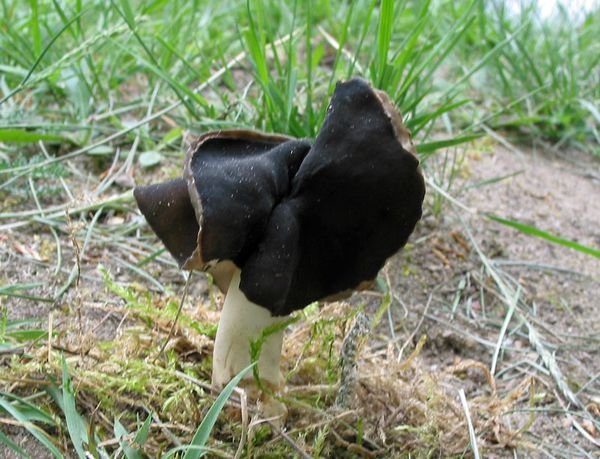
Helwella white-legged
Cap: 3-7 cm wide and high, with three or more petals, but often with only two; various shapes: in the form of a saddle from three different angles, and sometimes just randomly curved; in young specimens, the edges are almost even; the lower edge of each petal is usually attached to the pedicle at one point. The surface is more or less smooth and dark (from dark brown or grayish brown to blackish), sometimes with light brown spots. The underside is white or has a lightened cap color, with sparse hairs.
Leg: 4-12 cm long and 0.7-2 cm thick, flat or thickened towards the base, often flattened, but not ribbed or corrugated; smooth (not fleecy), often hollow or with holes in the base; white, sometimes with age there is a slight smoky brown tint; empty in cross section; becomes dirty yellowish with age.
Flesh: thin, rather brittle, rather dense in the stem, without pronounced taste and smell.
Spore powder: whitish. Spores are smooth, 16-23 * 12-15 microns
Habitat: White-legged lobster grows from May to October, singly, or in groups in mixed and coniferous forests, on the soil; prefers sandy soils.
Edible: like all representatives of this genus White-legged lobster is conditionally edible, poisonous in its raw form, therefore it requires long heat treatment. Edible after boiling for 15-20 minutes. In some countries it is used in traditional cooking.
Similar species: similar to Helvella sulcata, which, unlike Helvella spadicea, has a clearly ribbed stem, and can also be confused with Black Lobster (Helvella atra), whose stem is from gray to black.

